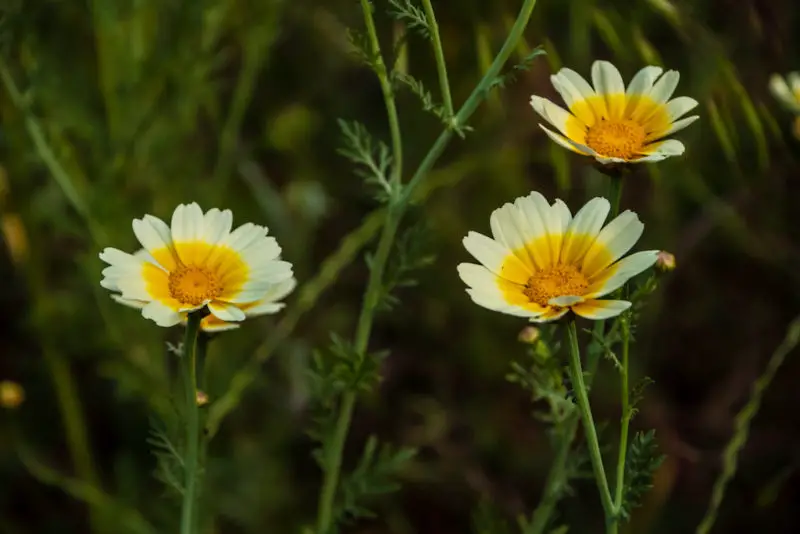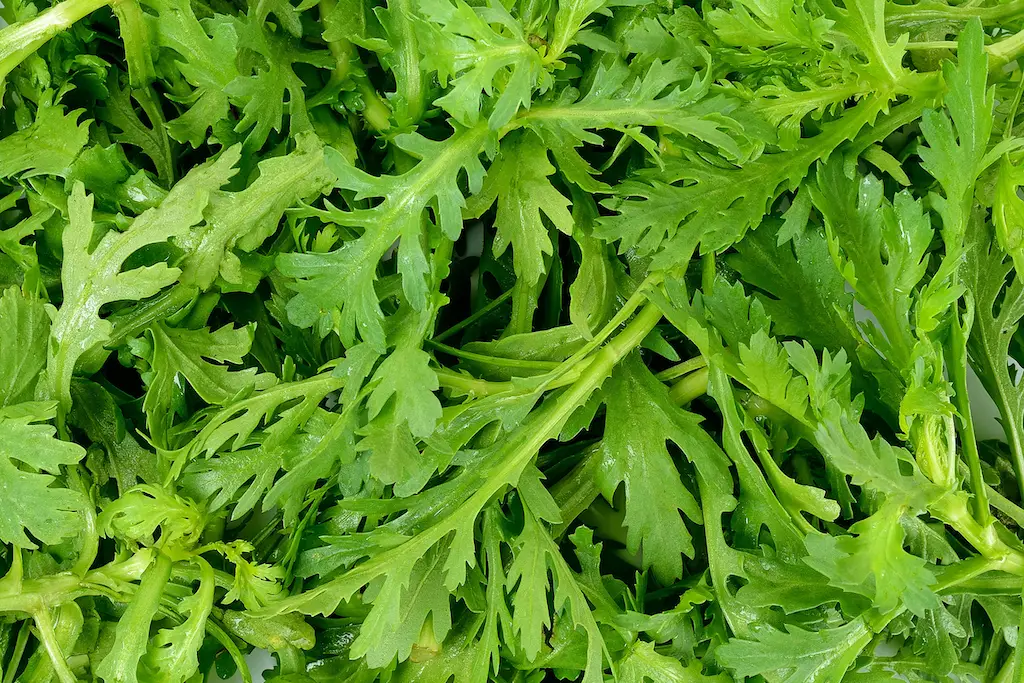This post may contain affiliate links. Please read my disclosure for details at the bottom of this page. As an Amazon Associate, I earn from qualifying purchases on this article about edible chrysanthemum greens in Korean cooking. We hope you enjoy learning about ssukgat.
Based on my ingredient articles about acorn starch and dandelion greens, you may notice that people in Korea eat ingredients that, though readily available wildly in the United States, we rarely eat. Chrysanthemum greens are no exception! While we enjoy looking at these beautiful flowers during the fall and spring months, people in South Korea also harvest them as a cooking ingredient.
In this article, we discuss this ingredient in-depth. Let’s get started!
What Are Chrysanthemum Greens?
Chrysanthemum greens are leafy stems of the Chrysanthemum plant of the Glebionis coronaria variety. Other names for this particular type of Chrysanthemum plant include shungiko ‘Spring Chrysanthemum,’ Chrysanthemum greens, garland Chrysanthemum, chop suey greens, crown daisy, kikuna, and mirabeles, among others.
In Japan, South Korea, and China, people use the Chrysanthemum greens as a cooking ingredient. This grassy flavored herb has a slightly bitter finish. The leaves are tender and crunchy. Often, people compare the flavor and texture to young spinach or mustard greens. If you buy the whole plant, you can eat the flowers as well!
Note: Not all Chrysanthemum varieties are edible. You need to make sure to plant, cut, or buy the Glebionis coronaria variety.
Information About Growing Chrysanthemum Greens:
Excitingly, edible Chrysanthemum greens are incredibly easy to grow during the cooler weather months of the year. For most American gardeners, you can get two harvesting seasons, early spring and fall, out of this crop. For gardeners in more temperate, mild winter areas, you can easily harvest this plant from the late fall, through winter, and into early spring!
Once you finish harvesting the plant for the season, let the stalks grow out to show their orange and yellow flowers. That way, your local pollinators can enjoy visiting your plants!
Chrysanthemum seeds usually germinate in 10-20 days in 60°F (15.5°C) soil. You can either directly sow into the ground as soon as the last frost passes or start germinating these plants in small pots a month before the last frost date.
After approximately 5 to 6 weeks, you can start harvesting the greens of the plants. Before doing so, make sure your plants are at least 4-6 inches tall.
Chrysanthemum Greens in Korean Cuisine:
In the Korean language, Chrysanthemum greens are known as ‘ssukgat’ (쑥갓).
In South Korea, people eat Chrysanthemum greens raw, as a garnish in soups and stews, or as a herbaceous ingredient in particular dishes. We list examples of some dishes that use this ingredient below:
- Ssukgat Namul (쑥갓나물): While often served as an added ingredient in dishes, sometimes Chrysanthemum greens are the main ingredient in a dish. Ssukgat namul is an example of such a dish. In English, you can translate ‘ssukgat namul’ as ‘Chrysanthemum greens side dish’ or ‘Chrysanthemum greens salad.’
- Dotorimuk-muchim (도토리묵무침): As I stated above, people use ssukgat as a herbaceous in a dish. In English, ‘dotorimuk-muchim’ can be translated to ‘seasoned acorn jelly.’ People often serve acorn jelly mixed with herbs such as perilla and Chrysanthemum greens.
- Eomuk Guk (어묵국): In English, ‘eomuk guk’ translates to ‘Korean fish cake soup.’ Also known as ‘odeng soup,’ this popular Korean soup often contains Chrysanthemum greens as a garnish.

Acorn Starch Powder Frequently Asked Questions:
Now that we learned about Chrysanthemum greens, we want to answer some questions you may have about this ingredient! If we do not answer your question, feel free to leave a comment in the section below or email us at [email protected].
Where Can I Buy Ssukgat?
Unfortunately, you cannot find this ingredient in your typical western-style grocery store (unless you are buying the entire plant from a plant nursery). Instead, shop for ssukgat at your local family-run Asian market or large Asian grocery chain when in season.
How Do I Choose the Best Bunch?
When shopping, look for bright, fresh-looking leaves. You do not want any obvious tears, slimy texture, or wilting. Further, avoid bunches with yellowing leaves–these tend to taste more bitter.
Finally, try to pick bunches with smaller leaves and stems. These have a more tender texture.
How Do I Properly Store This Ingredient?
To store this ingredient, place it in the refrigerator unwashed in a breathable bag.
How Long Does This Ingredient Last?
Uncooked and unwashed, this ingredient lasts in the refrigerator for 3 to 7 days.
For longer storage, I recommend blanching the greens before draining and squeezing out excess water. Then, freeze in freezer-safe bags.
We Hope You Enjoyed Learning About Chrysanthemum Greens!
In the end, we hope you enjoyed learning about Chrysanthemum greens! If so, let us know in the comment section!
If you would like to read more about cooking, you can find further recipes on our blog. We listed some of our favorite Carving A Journey Korean recipes below! For reference, many recipes are influenced by our blended Korean and Southern heritage.
Korean Ingredient Articles:
Korean Ingredient Articles:
- Dandelion Greens In Korean Cooking (Mindeulle)
- Korean Fermented Salted Shrimp (Saeujot)
- Yuzu in Korean Cooking (Yuja)
- What Is a Korean Melon? (Chamoe)
- Black Sesame Seeds in Korean Cooking (Heukimja)
Further Carving A Journey Recipes:
- Dandelion Green Side Dish Recipe (Mindeulle Namul Muchim)
- Korean Spinach Side Dish (Sigeumchi Namul)
- Sukju Namul Muchim (Korean Mung Bean Sprout Salad)
- Korean Seaweed Salad Recipe (Miyeok Namul)
- Korean Soybean Sprout Salad (Kongnamul Muchim)
If you have any questions or comments, you can also email us at [email protected].
And, finally, we would love to hear from you through our social media as well! You can follow us at @carvingajourney on Instagram, Facebook, and Pinterest. I also started a vlog Youtube channel! Or, if you would like more articles like these, you can subscribe to our blog by joining our mailing list. Let us know if you try using this ingredient when cooking! Thank you so much for stopping by!
Carving A Journey is a participant in the Amazon Services LLC Associates Program, an affiliate advertising program designed to provide a means for sites to earn advertising fees by advertising and linking to Amazon.com. Although we may earn commissions for our endorsement, recommendation, testimonial, and/or link to any products or services from this website, these opinions are my own and I fully support these products.

